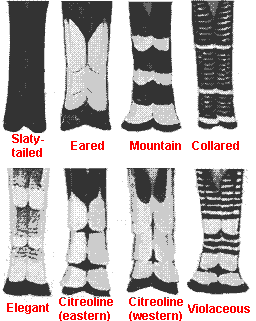Adapted from Jim Conrad's online book A Birding Trip through Mexico, This excerpt from "The Oak-Pine Forest of Bahuichivo" in western Chihuahua state
THE TROGON
Down next to the stream but keeping away from the perfect campground, a round boulder near the bank is perfect for clothes washing, and tree branches hanging low over the stream are perfect for drying. After the morning's scrubbing and hanging of clothes I sit on a boulder in mid-stream, staring blankly into deep shadows pooled behind a sycamore along the stream bank. A pale spot among the sun flecks twitches, and automatically my binoculars rise for a look. Silent and unmoving, an Elegant Trogon -- called Coppery-tailed Trogon in older books -- perches gazing right back at me.
Now, from a Northern birder's point of view, the five "most exotic" kinds of Mexican birds are probably the tinamous; parrots and parakeets; motmots; toucans... and; trogons. With their size, bright colors and stubby tails, Trogons look a little like parrots, but they lack the parrot's sharply downcurved beak.
The Trogon Family, the Trogonidae, is represented in the U.S. only in extreme southeastern Arizona, by the Elegant Trogon, and, very rarely, the Eared Trogon. Though some of the thirty-seven or so of the Earth's trogon species occur in Asia and Africa, trogons are mainly tropical American birds, with nine species breeding in Mexico.
The trogon before me now is behaving typically for trogons. They like to perch in fairly secluded, hidden locations, remaining very still. This lifestyle makes sense for trogons, whose main food is small fruits, with only occasional insects. Thus their diet is not nearly as energy-rich as that of a pure carnivore or nectar sipper. Trogons need time for fruits to work their way through lengthy intestines while enzymes break down the fruits' complex carbohydrates. They grab a fruit, then sit quietly as it digests.
Trogons have their own peculiar manner of "grabbing fruit." They flutter up to a small fruit and without landing take hold of it in their stubby, thick beaks, the upper mandibles of which are equipped with serrated edges. Not letting go, and most likely "sawing" at the fruit's moorings with those serrated mandible-edges, they simultaneously let the momentum and weight of their chunky bodies help them snap the fruit from its point of attachment. It all happens very quickly. Within five seconds a trogon can leave its perch, acquire a fruit, and then be back on its perch placidly digesting.
Most birds have four toes directed forward, with one toe pointed backward. A few, the best known of which are woodpeckers and parrots, have zygodactyl feet, on which two toes are in front and two behind. On normal zygodactyl feet the first and fourth toes are directed backward. However, there is one bird family in which the first and second toes are directed backward, not the first and fourth. This is the trogon family. The special word characterizing trogon feet is heterodactyl.
 When I need to identify a trogon first I note whether the belly area is red or yellow, for all Mexican trogon bellies are one or the other. Then I make a mental snapshot of the barring on the tail's undersides, for it is true that trogon tails are bar-coded. The sketch at the right shows the tails of males of several species. Female tails are usually a bit different.
When I need to identify a trogon first I note whether the belly area is red or yellow, for all Mexican trogon bellies are one or the other. Then I make a mental snapshot of the barring on the tail's undersides, for it is true that trogon tails are bar-coded. The sketch at the right shows the tails of males of several species. Female tails are usually a bit different.
Usually I hear trogons before I see them. They make very distinctive, low, nasal-sounding, far-carrying, monotonous calls like cow-cow-cow-cow...
However, the Elegant Trogon I'm seeing now deep inside the sycamore's shadows looks at me for fifteen minutes never making a peep and then in a wink of the eye silently flutters away. It's strictly by accident that I've seen this species, for I just happened to be staring at the very spot where it was. It hadn't even crossed my mind to be looking here for trogons.